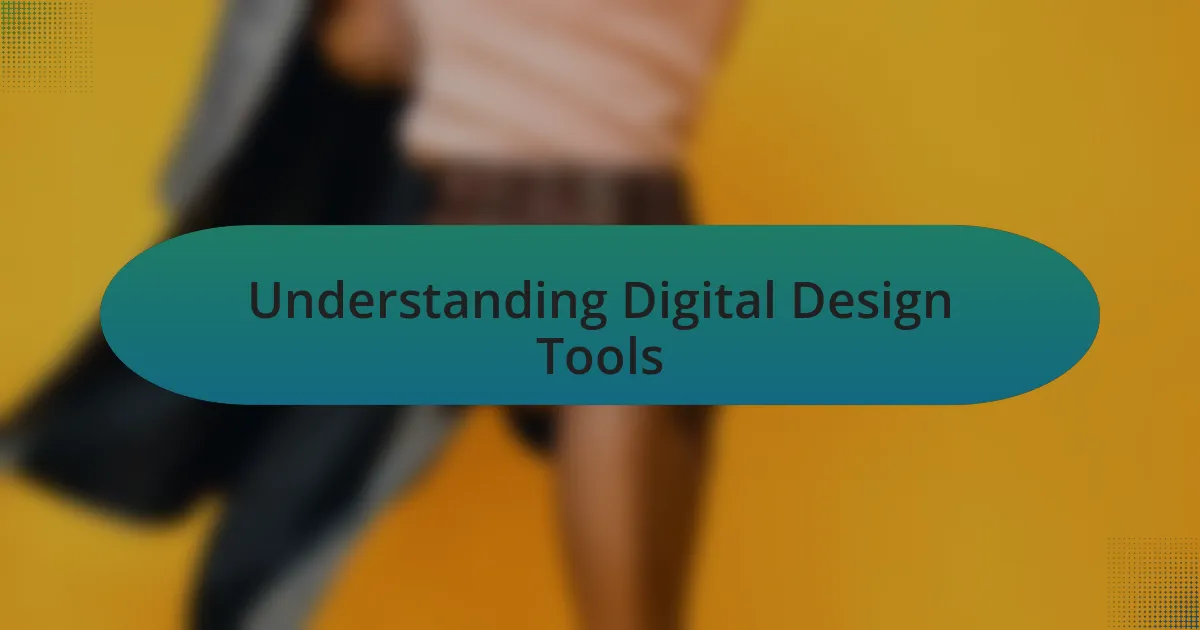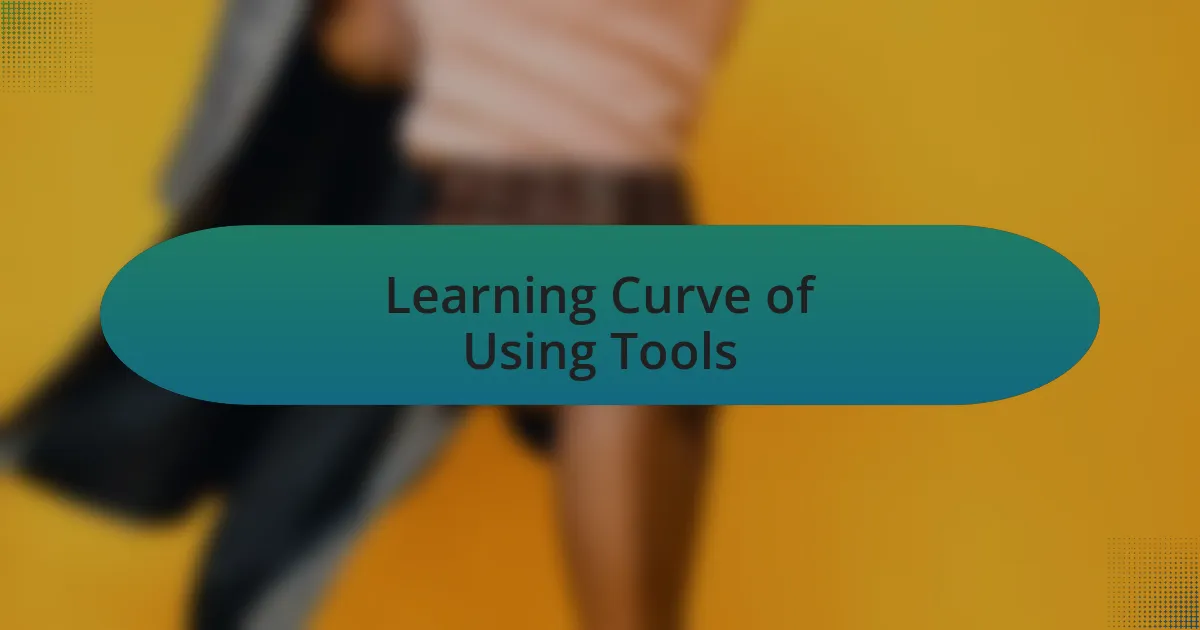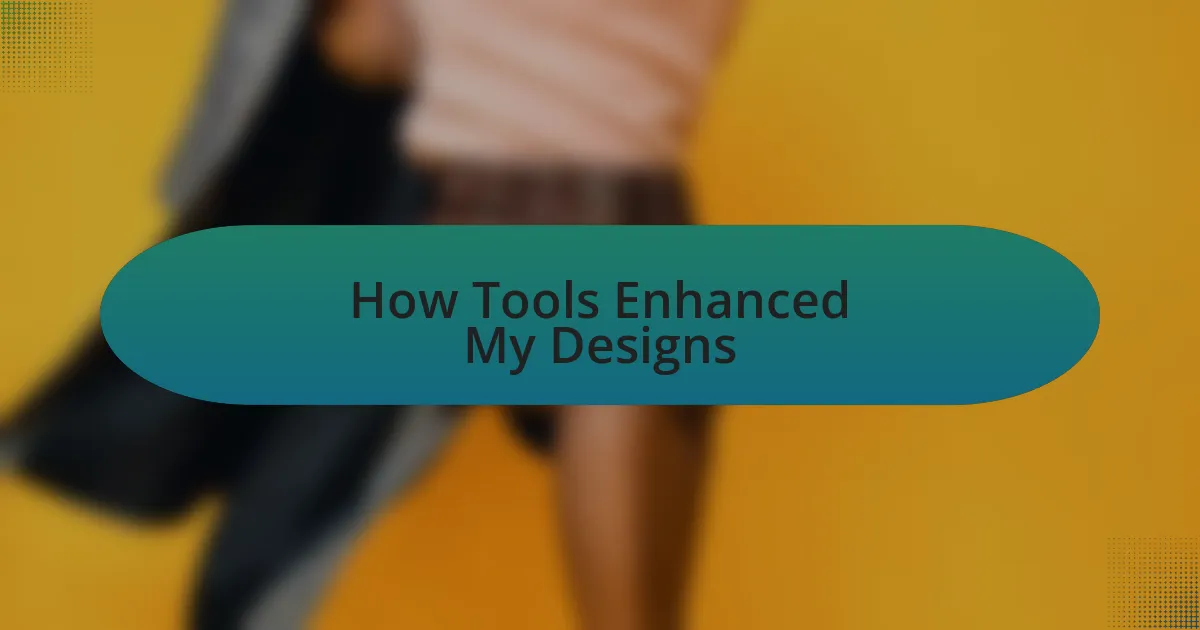Key takeaways:
- Understanding various digital design tools is essential for enhancing creativity and improving design quality.
- Exploring popular tools like Adobe Photoshop and Canva can make the creative process enjoyable and manageable for beginners.
- The importance of practice and community support significantly aids in mastering design tools and overcoming challenges.
- Utilizing digital tools allows for innovation in design, streamlining the process from concept to prototype effectively.

Understanding Digital Design Tools
When I first dipped my toes into the world of digital design tools, I was simultaneously excited and intimidated. It felt like stepping into a vast ocean filled with endless possibilities, but I often questioned: where do I even start? The sheer number of software options available can be overwhelming, but understanding the primary functions of these tools is crucial.
One thing I learned along the way is that not all design tools are created equal. From Adobe Illustrator to more beginner-friendly platforms like Canva, each tool has its own strengths. When I switched from traditional sketching to using Illustrator, it felt like unlocking a hidden treasure. The precision and control I gained propelled my designs to a level I hadn’t expected, making me wonder how I ever managed without it!
As I grew more comfortable with these tools, I discovered that they are not just about creating stunning visuals; they also enhance the creative process itself. I often find myself lost in the layers of a design, exploring different iterations and styles. Have you ever felt that rush of creativity when experimenting? That feeling, for me, solidified my appreciation for digital design tools as essential companions in my fashion design journey.

Overview of Popular Design Tools
When considering popular design tools, I always reflect on my early experiences with Adobe Photoshop. Initially, I was overwhelmed by the multitude of options, but as I began to explore its capabilities, I realized how important it was for creating detailed textures and imagery. I remember my first time using the layering techniques in Photoshop; it was like learning a new language where every layer brought my fashion illustrations to life.
Canva is another tool that deserves mention, especially for those just starting out. I fondly recall designing my first lookbook with its user-friendly interface and extensive template options. The ability to drag and drop elements made the creative process enjoyable rather than daunting. Have you ever stumbled upon a tool that feels so intuitive it reignites your passion for design? For me, Canva was that spark, allowing me to focus on creativity rather than technical hurdles.
Additionally, I can’t overlook the rise of Procreate on the iPad, which has truly changed the game for sketching on the go. I’ve had numerous moments where I could whip out my iPad and start illustrating wherever I was—be it a café or during a commute. The tactile experience of drawing digitally, infused with the joy of portability, has transformed my approach to fashion sketches. What about you? Have you found a tool that seamlessly fits into your lifestyle?

Learning Curve of Using Tools
Grasping the learning curve of digital design tools can feel like a daunting climb. When I first tackled Illustrator, I was met with a bewildering interface filled with options I had never seen before. I vividly remember spending hours watching tutorials, trying to understand how to manipulate vector shapes. Though it was challenging, that struggle ignited a determination in me to master this tool, and each small victory felt like a personal breakthrough.
As I navigated these tools, I discovered that practice was the key to overcoming obstacles. I often set aside dedicated time each week to experiment with design projects. One of my proudest moments was when a simple logo I created served as the foundation for a fashion label I dreamed of launching. That experience reinforced my belief that patience and perseverance can transform frustration into tangible results.
Reflecting on my journey, I realized the importance of a supportive community. Sharing my struggles with peers not only made the learning process easier, but their insights often provided solutions I hadn’t considered. Have you ever found that peer feedback elevates your understanding? For me, engaging with fellow designers turned my learning curve into a collaborative experience, enriching my skills far beyond self-study alone.

Tips and Tricks for Beginners
When I first started using digital design tools, I found myself overwhelmed by the sheer number of features and options. It’s easy to feel defeated by a complex interface, but I learned to break down each feature into manageable parts. For example, I spent an entire afternoon experimenting with color palettes. Each splash of color led to surprising combinations, turning a once-intimidating task into a fun, creative exploration.
One approach that truly enhanced my learning was the habit of setting small, achievable goals. Instead of trying to master everything at once, I focused on one tool or technique at a time. I remember tackling the pen tool in Illustrator for an entire week, and by the end, I could create intricate shapes that made my designs pop. Have you ever felt the satisfaction of overcoming a hurdle? That small victory not only boosted my confidence but also made each subsequent challenge feel less daunting.
Lastly, I can’t stress enough how valuable it is to seek feedback on your designs. Early on, I shared my work with fellow aspiring designers, and their constructive criticism opened my eyes to new possibilities. It’s amazing how an outsider’s perspective can illuminate aspects of your work you might have overlooked. Have you had moments when feedback transformed your understanding? For me, those discussions became pivotal in refining my style and approach to digital design.

How Tools Enhanced My Designs
Using digital design tools has truly elevated my creative process in ways I didn’t expect. The moment I discovered layering techniques in Photoshop, it felt like unlocking a treasure chest. I vividly remember creating my first layered fashion illustration; seeing different elements come together in harmony transformed a simple sketch into a vibrant piece of art. Have you experienced that euphoria of visually witnessing your ideas come to life?
Moreover, the incorporation of 3D design software has allowed me to experiment with textiles and patterns in a whole new dimension. I recall a late-night session where I played around with virtual draping simulations. As I watched the fabric move and flow on-screen, it gave me a clearer vision of how that design would interact with real-world materials. It’s exhilarating to know that my designs aren’t just flat images; they have potential to become dynamic pieces within a collection.
Additionally, the ability to pivot from concept to prototype digitally has streamlined my workflow immensely. I used to feel bogged down by the prototypes I created; now, with tools like Adobe XD, I can rapidly prototype and test ideas without wasting resources. I still remember the time I pivoted a whole concept based on a simple interaction I created in a mockup. Wouldn’t you agree that being able to visualize a design before it’s even made cuts down on a lot of guesswork? This capability not only saves time but also empowers me to innovate tirelessly.